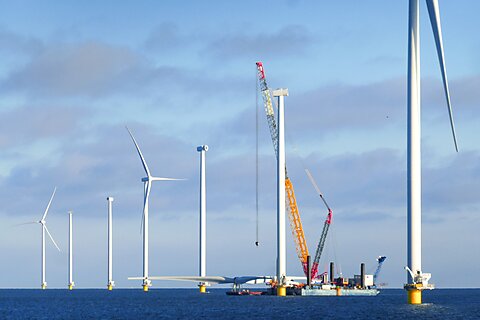
Travis Fisher
Offshore wind is one of the most expensive ways to generate electricity. It’s also a perennial favorite when politicians mandate a preferred electricity source. Time and again, East Coast policymakers bet their own political capital and their constituents’ dollars on offshore wind as the future of energy. That is a losing bet.
The fundamental problem with offshore wind mandates is that they do not align with the preferences of energy consumers, which is why the government must subsidize offshore wind for it to exist. But the broad political justification is also curiously absent. Recent polling suggests that just 38 percent of Americans are willing to increase their energy costs by $1 per month to address climate change. The cost of offshore wind exceeds that many times over, meaning offshore wind mandates are out of step with the will of the American people.
Offshore wind faces opposition from local groups because it threatens viewsheds and wildlife, but offshore wind mandates are bad public policy because they simply cost too much and would not be economically viable without taxpayer support. No one has proposed to build an offshore wind project in the United States without lavish subsidies, and the cost to everyday ratepayers is higher than most are willing to pay.
The list of states that have either signed contracts or laid out ambitious goals for offshore wind includes Massachusetts, Rhode Island, Connecticut, New York, New Jersey, Maryland, Virginia, North Carolina, and Louisiana. Offshore wind decrees can come from the legislature, like Maryland’s recent plan to install 8,500 megawatts (MW) of offshore wind capacity by the year 2031. They can also come from executive orders, like New Jersey’s goal to install 11,000 MW of offshore wind by 2040.
The federal government has goals of its own. In 2021, the Biden administration established a goal to deploy 30,000 MW of offshore wind in the United States by 2030. The fact sheet explains how various federal agencies can facilitate the 30 by 30 goal, including offshore permitting from the Department of Interior and loan guarantees from the Department of Energy.
Political Targets Meet Reality
In contrast to the ease and simplicity of issuing aspirational offshore wind plans, policymakers are now confronting the reality that offshore wind faces many obstacles. The second half of 2023 brought story after story of canceled or renegotiated contracts for offshore wind. BP and Equinor canceled their contract with the state of New York; Ørsted canceled two large projects in New Jersey; and developers in Massachusetts canceled four projects totaling 2,400 MW of offshore wind.
Electricity is already expensive in many Mid‐Atlantic and Northeastern states. According to the most recent data from the US Energy Information Administration (EIA), New York ranked 9th most expensive in the United States with a retail rate of about 23 cents per kilowatt‐hour (kWh). Maryland ranked 15th most expensive at 17 cents per kWh. Connecticut and Massachusetts ranked 3rd and 4th most expensive at 29 and 28 cents per kWh, respectively, coming in behind only Hawaii and California.
With such high electricity prices, one might expect political leaders to attempt to reduce the burden of the energy costs their constituents pay. Instead, policymakers in these states have insisted on mandating offshore wind, which will invariably increase electricity rates and impose a higher federal spending and tax burden on the country. There are several ways of looking at the cost of electricity from specific resources, such as wind off the East Coast of the United States. Unfortunately, offshore wind is expensive by every measure.
Contract Prices in Power Purchase Agreements (PPAs) and Levelized Revenue of Energy (LROE)
PPA prices are a generous way to examine the cost of offshore wind. They are the price paid by the offtakers of the energy from offshore wind projects—PPAs do not explicitly show the full cost paid by retail electricity consumers and taxpayers. These contract prices are usually expressed in wholesale units of dollars per megawatt‐hour ($/MWh).
As one example, the Vineyard Wind project off the coast of Massachusetts has a levelized PPA price of about $98/MWh (escalating from a lower base price to a higher final price at the end of a twenty‐year contract). As the National Renewable Energy Laboratory explained in 2019:
This LROE estimate for the first commercial‐scale offshore wind project in the United States appears to be within the range of LROE estimated for offshore wind projects recently tendered in Northern Europe with a start of commercial operation by the early 2020s. This suggests that the expected cost and risk premium for the initial set of US offshore wind projects might be less pronounced than anticipated by many industry observers and analysts.
Other operational projects, like the South Fork project in New York, don’t advertise the PPA price but have stated that “the power from South Fork Wind … will cost the average ratepayer between $1.39 and $1.54 per month when it starts operating.” (Recall that fewer than 40 percent of Americans are willing to spend $1 monthly to address climate change.)
In short, PPA prices tend to put the cost of offshore wind projects in the best light.
However, even PPA prices for offshore wind resources do not compare well to clearing prices in wholesale markets. Note the difference between the $98/MWh PPA for Vineyard Wind and the day‐ahead wholesale market prices in New England, which are less than half the PPA price at around $44/MWh.
Source: https://www.iso-ne.com/isoexpress/
The Levelized Cost of Energy (LCOE)
LCOE is a common measure of the cost of electricity from a given class of resources. LCOE boils down construction and operating costs into a single cost estimate (in dollars), divided by the energy output of the plant over its lifetime (in watt‐hours). Hence the familiar unit of dollars per megawatt‐hour. LCOE is a straightforward way to get a sense of the levelized (or averaged‐out) cost of a standalone power plant.
According to recent LCOE estimates from EIA, the unsubsidized cost of offshore wind exceeds $120/MWh and is among the most expensive generation resources. The consulting firm Lazard also publishes LCOE estimates that have become common reference points. In the latest Lazard research, the LCOE for offshore wind ranged between $72/MWh and $140/MWh.
Going by LCOE alone, offshore wind compares favorably to the highest‐cost natural gas generators ($115–221/MWh) but not to the lowest‐cost renewables ($24–75/MWh for onshore wind and $24–96/MWh for utility‐scale solar photovoltaics [PV]). Quietly outshining these new resources is existing nuclear energy, which has a levelized going‐forward cost (including decommissioning) of $31/MWh, according to Lazard.
Source: https://www.lazard.com/research-insights/2023-levelized-cost-of-energyplus/
The Full Cost of Electricity (FCOE) and Levelized Full System Cost of Electricity (LFSCOE)
Recently, scholars have expanded the LCOE model to include spillover costs that are borne by other generators on the system. To remedy the analytical shortcomings of LCOE, the FCOE approach zooms out and considers the all‐in cost of the entire electricity system. This is the appropriate measure to use when judging society‐wide costs because the full system costs are ultimately borne by retail ratepayers (and by taxpayers when subsidies are involved, as they are today).
The most important element of FCOE that is missing from LCOE is the cost to the rest of the system of intermittent output. Intermittent or “non‐dispatchable” generation always requires backup and balancing help from controllable or “dispatchable” resources to satisfy total electricity demand; however, the cost of making other resources fluctuate their output to accommodate intermittent generation—by backing down in times of high intermittent production and ramping up in times of low intermittent production—is not captured in LCOE estimates.
A group of authors who favor using the FCOE of solar PV and onshore wind said, “LCOE is inadequate to compare intermittent forms of energy generation with dispatchable ones and when making decisions at a country or society level.” A quick look at the very high‐solar grid in California (the California Independent System Operator or CAISO) illustrates this issue. The term “net load” describes the amount of demand (load) that remains to be met by dispatchable generation, net of production from intermittent sources.
Image source: https://www.eia.gov/todayinenergy/detail.php?id=56880
Intermittent wind and solar resources present different operational challenges. Although the solar PV output in California is predictable, it still requires a costly effort from dispatchable generators. Specifically, mostly natural gas‐fired generators must ramp down their output during the day and ramp up quickly in the evening to reliably meet grid demand. Wind output is more random than solar output—even for offshore wind facilities—but the costs imposed on the fleet of dispatchable generators are similar.
Another scholar recently described the Levelized Full System Costs of Electricity (LFSCOE) as follows:
The LFSCOE are defined as the costs of providing electricity by a given generation technology, assuming that a particular market has to be supplied solely by this source of electricity plus storage. Methodologically, the LFSCOE for intermittent or baseload technologies are the opposite extreme of the LCOE. While the latter implicitly assume that a respective source has no obligation to balance the market and meet the demand (and thus demand patterns and intermittency can be ignored), LFSCOE assume that this source has maximal balancing and supply obligations.
Under the LFSCOE assumptions, the cost of onshore wind in Texas is approximately seven times higher than its LCOE (an LFSCOE of $291/MWh compared to an LCOE of $40/MWh). The details of applying an LFSCOE to offshore wind would only be slightly different from applying it to onshore wind. Specifically, offshore wind has a slightly higher capacity factor than onshore wind (about 43 percent versus 34 percent in 2018, according to the International Renewable Energy Agency’s 2019 “Future of Wind” report). However, offshore wind is still an intermittent resource, meaning its LFSCOE is higher than its LCOE.
State Policy, Federal Costs
The cost of state‐level mandates for offshore wind does not stay within state borders. Through federal subsidies like the Production Tax Credit (PTC) included in the Inflation Reduction Act, taxpayers across the country are poised to pay for offshore wind. And it will not be cheap—the PTC offers a lucrative tax credit of $27.50/MWh. Returning to the day‐ahead wholesale prices in New England of $44/MWh, the federal subsidy alone represents a hefty 62 percent increase in revenue for wind producers.
As previously covered in this space, the final cost of the PTC by the time it phases down—which could take decades—could reach into the multiple trillions of dollars. Offshore wind’s share of that total would be a modest portion of that (but nothing to sneeze at). If the Biden administration achieves its goal of 30,000 MW of offshore wind and those facilities operate for 30 years at a capacity factor of 43 percent, the total federal taxpayer bill for offshore wind would be over $93 billion. (Note: Although each new facility is supposed to claim the PTC for only 10 years, in practice, owners of many facilities “repower” them: they make enough material changes to the facility to continue to qualify for the PTC for subsequent rounds of 10‐year eligibility.)
Conclusion
Ambitions for offshore wind are easy breezy—mandating offshore wind development seems like smooth sailing. The harsh reality of offshore wind mandates is that they are incredibly costly. Ratepayers and taxpayers will feel the sting of these decisions for years, potentially decades. Policymakers need to understand the full costs of their actions and come back to the shore. The American people simply don’t want to pay more for energy—not in their electricity bills and not in their tax bills.







